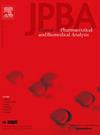利用液相色谱法/高分辨质谱法鉴定体外人体微粒体中甲基三烯醇酮的新代谢物,用于兴奋剂控制。
IF 3.1
3区 医学
Q2 CHEMISTRY, ANALYTICAL
Journal of pharmaceutical and biomedical analysis
Pub Date : 2024-10-28
DOI:10.1016/j.jpba.2024.116552
引用次数: 0
摘要
甲基三烯醇酮(17β-羟基-17α-甲基雌甾-4,9,11-三烯-3-酮)是世界反兴奋剂机构(WADA)禁用的合成代谢雄性类固醇(AAS)之一。甲基三烯醇酮的生物转化是通过人体肝细胞微粒体在体外进行的。对第一阶段和第二阶段实验都进行了研究。孵育样品经提取后注入液相色谱/高分辨质谱仪(LC-HRMS),或与甲氧基胺(添加 29 Da)或羟胺(添加 15 Da)反应,以提高检测灵敏度。比较了阴性对照组和阳性样品的提取离子色谱图,发现了 7 组 I 期代谢物。根据高分辨质谱的质谱图,观察并初步确定了代谢途径,包括 17-环化、单羟基化、二羟基化、还原结合单羟基化或二羟基化,以及 18-去甲代谢物。18-nor 代谢物有可能成为兴奋剂控制分析中的长期代谢物。其主要的第二阶段代谢物、代谢物的葡糖醛酸盐均已获得并进行了分析。本文章由计算机程序翻译,如有差异,请以英文原文为准。
New metabolites of methyltrienolone by in vitro human microsome and characterized using Liquid Chromatography/High Resolution Mass Spectrometry for doping control purposes
Methyltrienolone (17β-hydroxy-17α-methylestra-4,9,11-trien-3-one) is one of the anabolic androgenic steroids (AAS) banned by the World Anti-Doping Agency (WADA). The biotransformation of methyltrienolone is performed in vitro by human hepatocytes microsomes. Both phase I and phase II experiments are investigated. The incubation samples were extracted and injected to Liquid Chromatography/High Resolution Mass Spectrometry (LC-HRMS), or reacted with methoxylamine (29 Da added) or hydroxylamine (15 Da added), to increase the detection sensitivity. The extracted ion chromatograms of the negative control and the positive samples are compared, and 7 groups of phase I metabolites were found. The metabolic pathways including 17-epimerization, mono-hydroxylation, dihydroxylation, reduced combining mono- or dihydroxylation, as well as 18-nor which are observed and tentatively identified according to the mass spectra by high resolution mass spectrometry. The 18-nor metabolites will potentially be the long-term metabolite in doping control analysis. Its main phase II metabolites, glucuronides of metabolites are all obtained and analyzed.
求助全文
通过发布文献求助,成功后即可免费获取论文全文。
去求助
来源期刊
CiteScore
6.70
自引率
5.90%
发文量
588
审稿时长
37 days
期刊介绍:
This journal is an international medium directed towards the needs of academic, clinical, government and industrial analysis by publishing original research reports and critical reviews on pharmaceutical and biomedical analysis. It covers the interdisciplinary aspects of analysis in the pharmaceutical, biomedical and clinical sciences, including developments in analytical methodology, instrumentation, computation and interpretation. Submissions on novel applications focusing on drug purity and stability studies, pharmacokinetics, therapeutic monitoring, metabolic profiling; drug-related aspects of analytical biochemistry and forensic toxicology; quality assurance in the pharmaceutical industry are also welcome.
Studies from areas of well established and poorly selective methods, such as UV-VIS spectrophotometry (including derivative and multi-wavelength measurements), basic electroanalytical (potentiometric, polarographic and voltammetric) methods, fluorimetry, flow-injection analysis, etc. are accepted for publication in exceptional cases only, if a unique and substantial advantage over presently known systems is demonstrated. The same applies to the assay of simple drug formulations by any kind of methods and the determination of drugs in biological samples based merely on spiked samples. Drug purity/stability studies should contain information on the structure elucidation of the impurities/degradants.

 求助内容:
求助内容: 应助结果提醒方式:
应助结果提醒方式:


